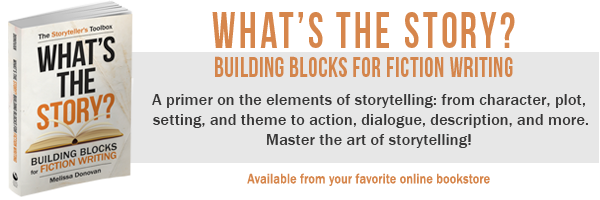Today’s post includes excerpts from What’s the Story? Building Blocks for Fiction Writing, which is packed with fun lessons and engaging activities for anyone who wants to learn the basics of storytelling. This is from chapter four: “Theme.” Enjoy!
What is the Theme of a Story?
Theme is one of the most difficult story elements to understand. Often confused with plot, theme is actually a worldview, philosophy, message, moral, ethical question, or lesson. However, these labels, taken alone or together, don’t quite explain theme in fiction.
We can think of a theme as an underlying principle or concept, the topic at the center of the story.
Themes are often universal in nature. Some common universal themes are based on motifs of redemption, freedom, equality, sacrifice, betrayal, loyalty, greed, justice, oppression, revenge, and love. Themes can also be personal and part of the human condition. Such themes could explore issues surrounding loneliness, trust, commitment, or family.
However, a story’s theme is more than an idea that can be expressed in a single word. The concept of freedom can form the foundation of a story’s theme, which could be anything from “one should not sacrifice freedom for security” to “freedom is worth dying for.”
Themes in Storytelling
Most stories contain multiple themes and motifs; The Hunger Games trilogy explores motifs of power, class, sacrifice, and honor, to name a few. In the Harry Potter books, the most significant themes are good versus evil and the power of love. However, there are also motifs of friendship and loyalty. One theme might stretch across an entire series, while other themes appear at the novel or even chapter level. A story’s main plot might explore one theme while its subplots explore other themes.
The strongest stories tend to use themes that are interconnected and complement or contrast with one another. The 1997 film Titanic is rich with themes that swirl around class (wealth versus poverty). These themes are echoed in the main characters: the protagonist is an aristocrat; she falls in love with a poor artist. The ship itself is segregated with the wealthy residing on the luxurious upper decks and the poor relegated to the cramped and crowded accommodations in the lower decks. And at the center of the story, the protagonist, Rose, is struggling with whether she should give up her financial security in order to liberate herself from the wealthy fiancé she loathes.
Theme can be obvious, but often it’s nuanced. In the 2009 film Avatar, the theme is in your face: preservation of the environment and respect for native cultures. In the 2005 film Batman Begins, theme is harder to put your finger on: one man’s struggle with his own identity and duality.
Choosing the Theme of a Story
Themes are so closely tied to human nature that it’s almost impossible to tell a story without a theme of some kind. Themes will almost always manifest, even if an author doesn’t put any special effort into theme development.
Some experts have suggested that authors shouldn’t think too much about theme until they’ve produced a draft, while others believe that theme is so integral that it should be present throughout story development. The approach you choose will depend on your writing process, storytelling style, and personal preference.
Theme could be considered the glue that holds a story together, the binding principle of the narrative. It is the deeper meaning, the truth that underscores the plot and characters.
Tips for Developing Theme
- Learn to identify themes. When watching movies and reading novels, identify the themes. When you become proficient at identifying themes in other works, you’ll get better at bringing themes into your own work.
- Don’t stress yet. If you’re not sure what your story’s theme is, don’t put too much pressure on yourself. A theme will usually emerge as you work through your first draft.
- Theme development. Once you’ve completed a draft, the theme should be apparent. Take some time to think about how you can strengthen the theme in future drafts.
- Multiple themes. Once you identify your theme, make a list of related themes that you could thread into subplots. For example, if your theme is related to redemption, then forgiveness could be a secondary theme.
- Theme and motif. Check your work by making a list of all motifs and themes in your story. This is a map of your thematic pattern.
To get more tips on developing themes in your storytelling, pick up a copy of What’s the Story? Building Blocks for Fiction Writing.






Hello, i am a teenager who loves to write stories that has a lesson that i think the reader should learn. As a experienced writer, do you have any tips to help me excel in story writing?
The two most important practices for any writer are reading and writing. Try to read and write every day — even if you can only invest twenty minutes. Good luck!